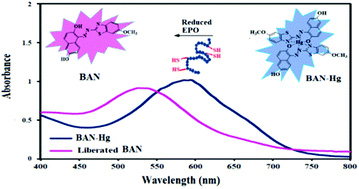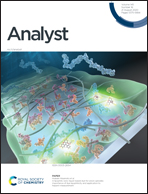Rapid and selective detection of recombinant human erythropoietin in human blood plasma by a sensitive optical sensor†
Abstract
Recombinant human erythropoietin (rHuEPO) is an important hormone drug that is used to treat several medical conditions. It is also frequently abused by athletes as a performance enhancing agent at sporting events. The time window of the rHuEPO in blood is short. Therefore, the rapid detection of rHuEPO use/abuse at points of care and in sports requires a selective analytical method and a sensitive sensor. Herein, we present a highly selective method for the rapid detection of rHuEPO in human blood plasma by a sensitive optical sensor. rHuEPO is selectively extracted from human blood plasma by a target-specific extractor chip and converted into a biothiol by reducing its disulfide bond structure. The formed biothiol reacts with a water soluble (E)-1-((6-methoxybenzo[d]thiazole-2-yl)diazenyl)naphthalene-2,6-diolHg(II) (BAN-Hg) optical sensor and causes its rapid decomposition. This leads to a rapid change in the sensor color from blue to pink that can be observed by the naked eye. The optical sensor was used to quantify rHuEPO in the concentration range 1 × 10−8 M to 1 × 10−12 M by UV–Vis spectroscopy. For the screening of blood plasma, an EPO-specific extractor chip was synthesized and used to selectively extract the protein from the biological matrix prior to its conversion into biothiol and quantification by the optical sensor. Since many proteins have a disulfide bond structure, the new method has strong potential for their rapid sensitive and selective detection by the BAN-Hg sensor and UV–Vis spectroscopy.



 Please wait while we load your content...
Please wait while we load your content...